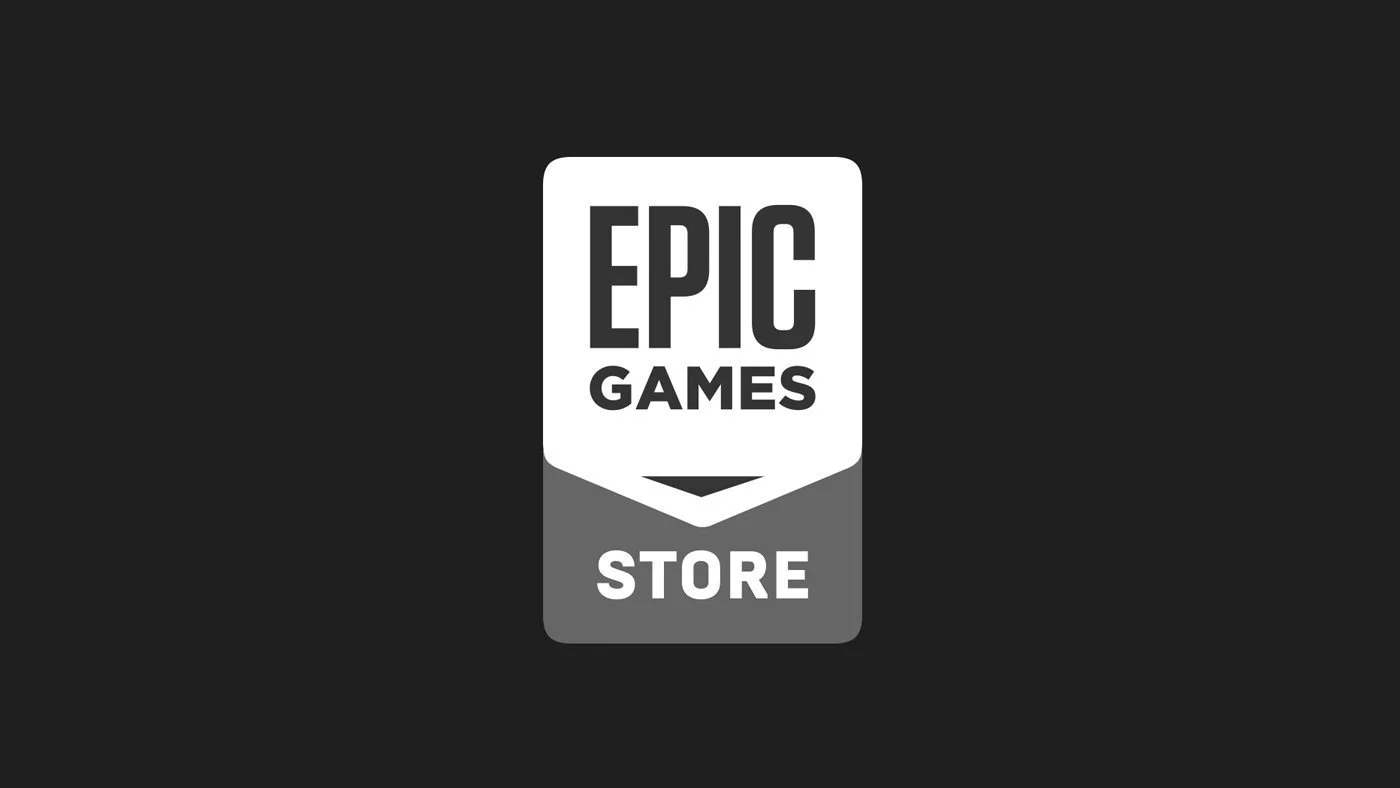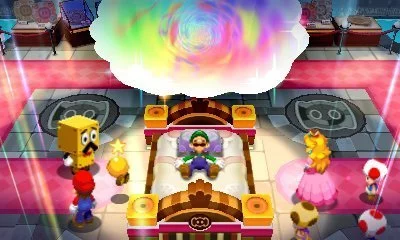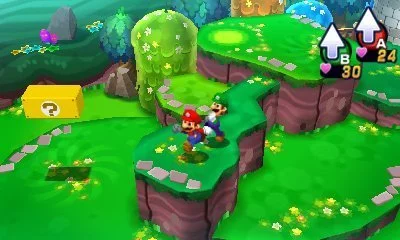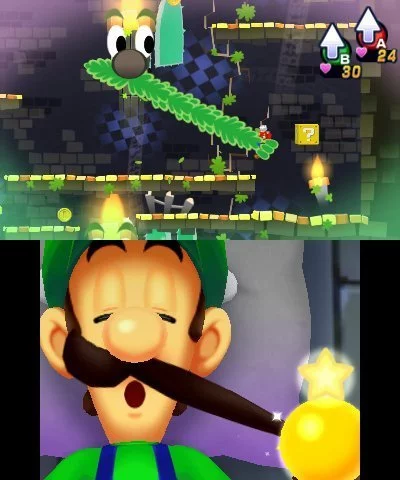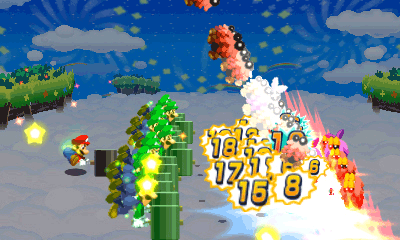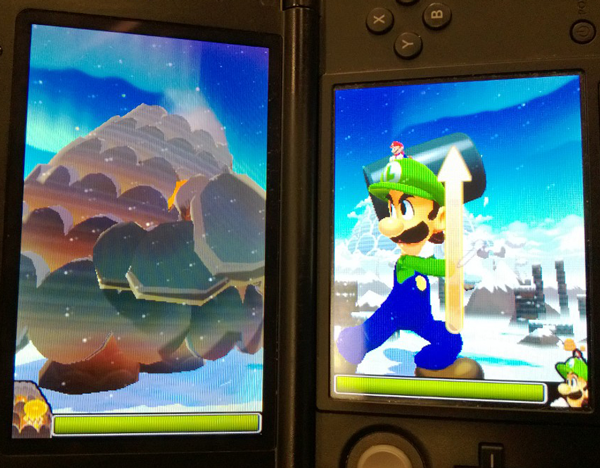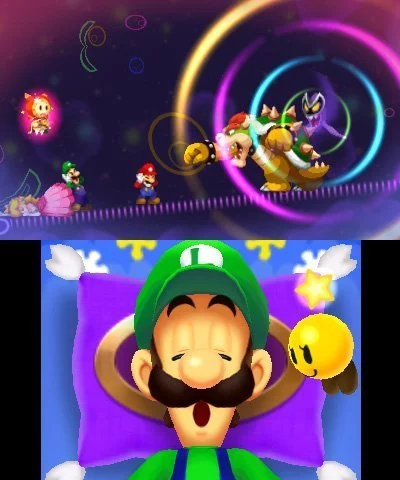Mario & Luigi: Dream Team Bros is the fourth installment in the popular action RPG series from Nintendo. Developed by AlphaDream, it successfully mixes many different game styles to create a title that’s unique, innovative and exceptionally fun.
Set in the brand new location of Pi’illo Island it’s clear from the start that AlphaDream know their Mario Bros. lore. From the story to gameplay; special moves to dialogue, everything about Dream Team Bros. reeks of Mario culture. Packed full of references, there’s lots for people to enjoy whether they’ve played a preceding title or not.
Dream Team Bros. tells an original story, unrelated to preceding games. While holidaying at Pi’illo Island, Luigi discovers he has a special talent. When he sleeps on one of the island’s stone pillows, a magical portal to a dream world appears! It turns out that the stone pillows are actually trapped Pi’illo folk, who were encased in their stony prisons by the evil Bat King, Antasma. Mario must then navigate his way between the dream world and the real world, rescuing the Pi’illo folk, Peach and, of course, the world.
The story, whilst important, isn’t overly interesting and shouldn’t be a deciding factor when choosing this game. It’s enjoyable, has some great characters and provides you with clear goals but feels more like a series of mini stories rather than components of a whole. That said this is a Mario Bros. game, so a simple or kiddie story is to be expected.
By splitting the game into two sections, Dream Team Bros. does a great job of offering two unique styles of gameplay within one title. The real world is presented in an isometric view fashioned similar to a traditional JRPG or Legend of Zelda game. You walk around talking to people, completing quests, solving puzzles, following the story, and so on. The dream world is presented via a series of 2D side scrolling mini levels, which you access via stone pillows dotted around Pi’illo Island. No matter which world you’re in the base gameplay mechanics are very similar which keeps the game feeling consistent yet varied.
As this is an action RPG, navigation thru the worlds requires skill. Well… more skill than just walking up to people or objects and pressing an action button. Whilst you start off with only the jump ability, it’s not long before you unlock a host of new abilities such as hammer smashes, spin jumps, underground tunnelling and more. Each new skill gives access to new areas of Pi’illo Island or the ability to complete previously inaccessible dream world levels/puzzles.
One of the key gameplay mechanics in Mario & Luigi titles is the way in which you control the brothers. At any time you have simultaneous control over both brothers with a button assigned to each. So, if you want both brothers to jump onto a ledge, you need to press both buttons at once. If you want Luigi to shrink Mario by pounding him with a hammer just press Luigi’s button with the hammer equipped. Whilst it may sound complicated the interface is very intuitive and very easy to get the hang of.
When in the dream world things are slightly different. As you’re inside Luigi’s dream you’re given a dream version of Luigi in lieu of the real one. Whilst his base functions are the same you soon learn that Dreamy Luigi gives you a whole new set of unique skills and special attacks with which to beat the levels.
In addition to being more handsome Dreamy Luigi has the ability to multiply himself giving Mario access to new heights, the constitution to destroy swathes of enemies or controlling switches/level mechanics. Furthermore in certain areas the stylus can be used on the touch screen to interact with Luigi’s face and affect the level. Tickle his nose and he’ll sneeze, blowing items into the foreground or rotating platforms. You could pull on his moustache to create a slingshot or even control the speed of time to assist Mario past obstacles. Just as intuitive as the real world mechanics these are extremely fun and give a unique way to play a 2D platformer.
There’s one last gameplay element to cover which is battle. In Dream Team Bros Combat is turn based, however, in a twist to the classic formula there’s a heavy action element involved. For normal attacks you must time your button presses to achieve maximum effect. As an example, select the jump attack then press the button again just as you land on the bad guys’ noggin to get some bonus damage. In some cases, like with the hammer attack, failure to hit that mark results in a failed attack and no damage at all.
This format is carried over for defence as well. Each enemy has a unique set of attacks which can be avoided or countered with timed positioning, jumps or hammer swings. The variety of enemy moves is impressive and keeps combat feeling fresh. With every new enemy comes a new set of tells and counters to learn. Another great feature of this system is that, if you’re good enough, your character stats (attack, defence, health, etc.) don’t really matter. Nail an excellent hit every time and counter/dodge all enemies moves and you’re stats only affect how long the battle takes, not the result. Alternatively, if you’re finding the battle a little difficult, you can fall back on the RPG elements of the game and save for better equipment or grind to level up the brothers.
In additional to the standard moves you have specials called Luiginary attacks. When used Luiginary attacks start a minigame where your performance determines how much damage you do. Some require timed button presses, others use features like tilting the DS to steer along a path. They’re all extremely fun and a great way to keep the combat varied and interesting.
Whilst the variety in content ensure the mechanics never grow old the pace they’re introduced could have been better. They offer a great suite of moves and mechanics but move on too fast and re-use them too little. It’s better than milking a mechanic to adding length with repetition but I was left feeling the game was a little rushed. This is especially noticable for the first half of the game where you spend a lot of time speeding theru unskippable and patronising tutorials. No sooner do you come across a problem than a dialogue begins telling you how to bypass it. Whilst it ensures you never get stuck there were times I felt robbed of the discovery experience as I spent as much time watching tutorials as I did using what they were showing me. Luckily this is toned down later on and the second half of the is considerably better paced.
Another downside of Dream Team Bros was there wasn’t a lot of scope to use your imagination. Levels were all fairly straightforward without much side area exploration or bonuses. In later stages of the game there are areas to revisit and side tasks to complete, however, I was left feeling the game world was fairly small and linear.
Graphically Dream Team Bros is a mixed bag. Some areas look fantastic whilst others look average. The dream world looks vibrant and interesting, battle uses 3D to great advantage but the real world looks kind of bland.The character sprites look kind of pixelated too which felt out of place with the surrounding areas. I’ve played better looking 3DS titles so this is obviously a design choice rather than a system restriction. I can only assume they were trying to keep the cartooney feel of previous titles however I feel they could have achieved this better without making it feel as disjointed.
Musically the game is ok. Not great, not terrible; just ok. The music is catchy enough but over used and quickly tiresome. Luckily the special effects sounds are perfect and ensure you won’t be turning down the volume. Hitting an excellent (aka critical) hit on an enemy results in an audible sound accompanied by a bright screen flash like you’ve won at the Pokies! It’s not a major game element but the little sound effects or ipsem lorem speech used when a character talks makes the game feel complete.
Once you finish the game there’s a bit of replay offered via in game challenges (defeat enemy X without getting hit, get ten excellents in a row, etc.), items to collect, Pi’illo folk to save and extra areas to discover. Unlike normal collectibles these are all actually useful, however, I felt added gameplay via side stories/quests would have been preferable.
If you’re after a traditional or challenging RPG then this game probably isn’t for you. It’s target market is definitely a younger audience however it can be easily enjoyed by those of use past the 30 year old mark as well. If you like Mario platforming but want something with a bit more story then this might be the exact title you need. It lacks the pace of a platformer but the action components ensure it never degrades to a point where you cease to pay attention. Personally I loved the game. Whilst it’s not as good as Bowser’s Inside Story it’s a must for any Mario fan’s collection.
This article may contain affiliate links, meaning we could earn a small commission if you click-through and make a purchase. Stevivor is an independent outlet and our journalism is in no way influenced by any advertiser or commercial initiative.



